The Museum of Malaga is one of the most modern museums in Malaga, and yet it houses the oldest treasures of the city. It is housed in the Palacio de la Aduana, an imposing classicist building that you must visit if history and art are any of your passions.
NOTE: We are going to tell you a little about the history of the Museum of Malaga and the treasures that are kept here. But nothing compares to walking through its rooms that creak like the deck of an old ship in the port of Malaga.
What you will find here
HISTORY OF THE MUSEUM OF MÁLAGA
The history of the Museum of Málaga is the history of two museums. From a fine arts museum and an archaeological museum is born the spectacular Museo de Málaga, also known as the Museo de la Aduana because it is located in the Palacio de la Aduana.
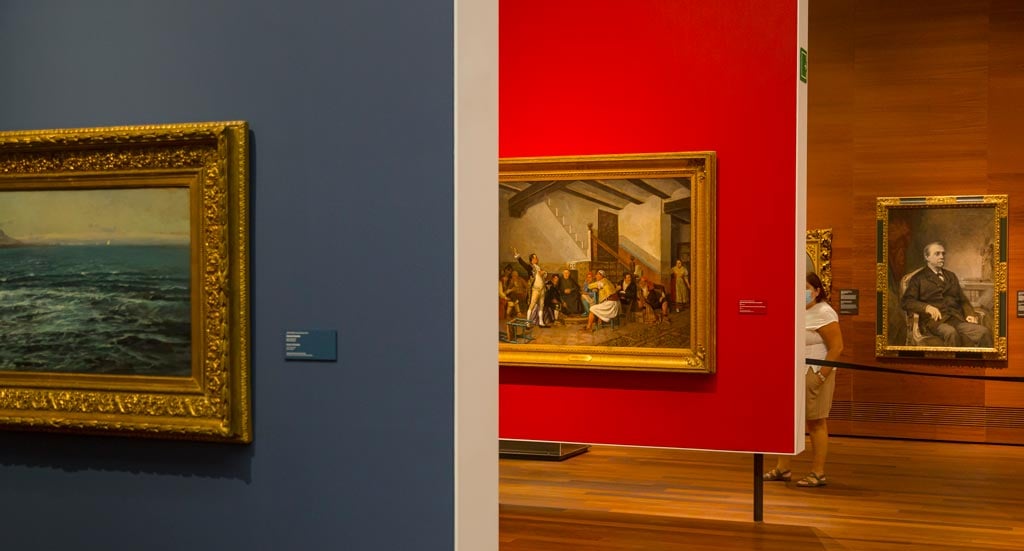
Halls of the Fine Arts section of the Museum of Málaga.
THE ORIGIN OF THE COLLECTIONS
PROVINCIAL MUSEUM OF FINE ARTS (1913)
In 1914 the Directorate General of Fine Arts began to function as a section of the Ministry of Public Instruction and Fine Arts. This was the definitive impetus for the creation of almost all the provincial museums of Fine Arts in Spain. Although its opening was set out in a royal decree of 1913, it was not until 1916 that it opened its doors. This first museum collected paintings and sculptures mainly from disentailments, donations and old state collections from the 19th century.
During the Second Republic there was a figure who played a particularly important role in the growth of the Malaga Fine Arts Museum. It was Ricardo de Orueta y Duarte who promoted the creation of a “collection of old masters” through an active policy of deposits from the Prado Museum.
The Fine Arts Museum of Malaga passed through several illustrious buildings in the city, until it found its place in the Palace of the Counts of Buenavista in the 1950s. In 1996 it left this site, which was subsequently occupied by the Picasso Museum.
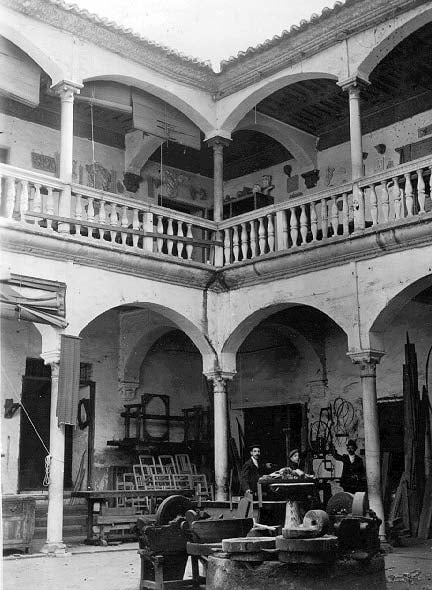
Central courtyard of the Palace of the Counts of Buenavista in Málaga (© Diputación de Málaga).
PROVINCIAL ARCHAEOLOGICAL MUSEUM (1945)
Archaeological museums in Spain originated in the mid-19th century and are closely related to the development of Enlightenment ideas and the concept of the “public good”. The Provincial Archaeological Museum was created in 1945 and was installed in the same Alcazaba of the city. However, in Malaga there was a singular precedent, the Loringian Museum. The Marquises of Loring bought thousands of archaeological objects during the second half of the 19th century. Much of this collection passed to the first Provincial Archaeological Museum in the Alcazaba. Over time, important collections were added from purchases, donations and finds.
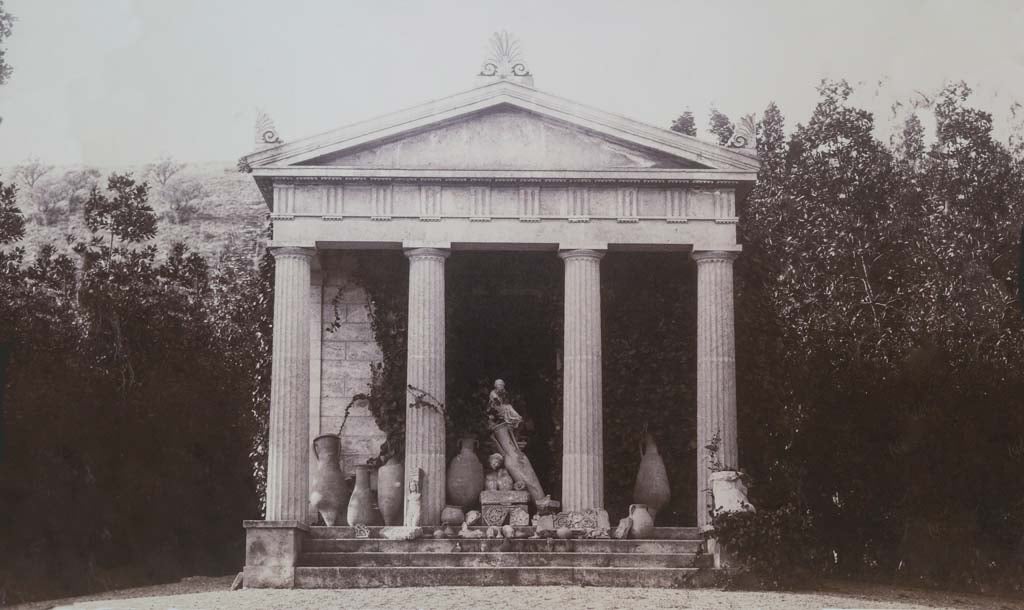
Old photograph of the Loringiano Museum (© Diputación de Málaga).
THE MUSEUM OF MÁLAGA AND THE CUSTOMS PALACE
It will be in 1972 when the two museums will be united into a single institution, although each will maintain its own headquarters.
THE CUSTOMS PALACE
The Palacio de la Aduana (customs house) is known by this name for its customs and administrative functions. However, its first use in the 19th century was as the headquarters of the Tobacco Factory. Until 2008 it was the headquarters of the Civil Government in the City, a police station and a warehouse for the Museum of Malaga.
This imposing neoclassical building used to stand almost on the quay itself, as the port has been gaining space from the sea over the years. It was conceived at the end of the 18th century by Manuel Martín Rodríguez, but it was not until 1829 that the works were completed.
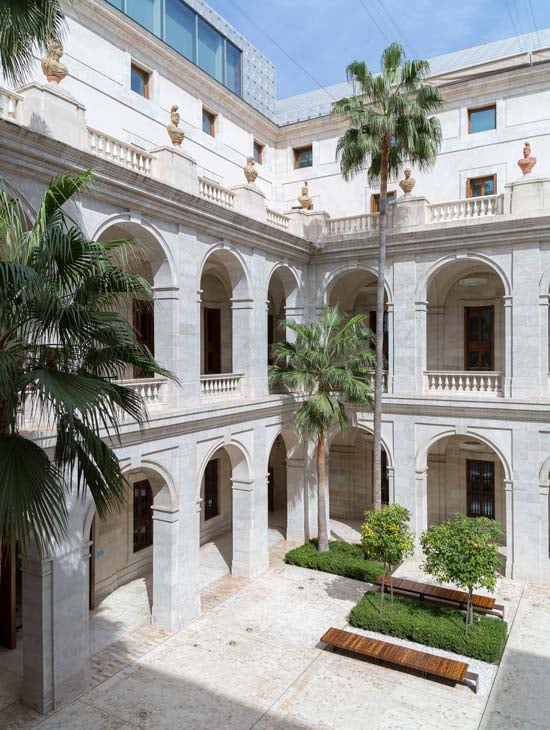
Interior of the Palacio de la Aduana nowadays and restored as Museo de Málaga.
A curiosity, in 1923 it suffered a major fire that destroyed the roofs of the building and caused a strong commotion among the people of Malaga.
THE MUSEUM OF MÁLAGA
Between 1996 and 1997 the two sites of the Museum of Málaga were closed. Years later, citizens began to demand the reopening of the Museum, which led to a mobilisation in the streets. Although in 2005 the institutions reached an agreement to build a new museum, it was not until 2016 that the great Museum of Malaga was reopened in the Palacio de la Aduana.
THE TREASURES OF THE MUSEUM OF MÁLAGA
Let’s now get to know the collections of the Museum of Málaga.
PRE-HISTORY
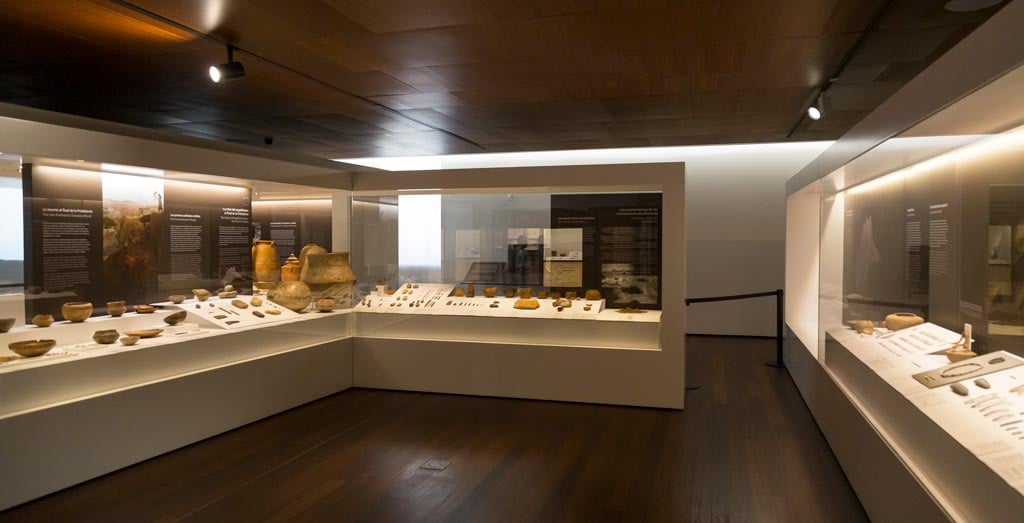
One of the prehistory rooms of the Museum of Malaga.
Archaeological sites in the province of Malaga have provided the Museum of Malaga with numerous unique pieces. In the prehistoric rooms you can get to know the megalithic culture through its domestic and sumptuary trousseau. One of the most striking pieces is known as the “Venus of Benaoján”, recovered from the Cueva de la Pileta and dated between the 3rd and 2nd millennium BC.
IBERS
The Iberians were a culture forgotten for centuries, but fundamental to understanding the transition between prehistory and the Ancient Age. They are sometimes considered to be the indigenous tribes of the Iberian Peninsula. The Museum of Malaga has an important collection of vessels from the sites of Aratispi in Antequera, Acinipo and Silla del Moro in Ronda, Alcorrínen in Manilva, among others.
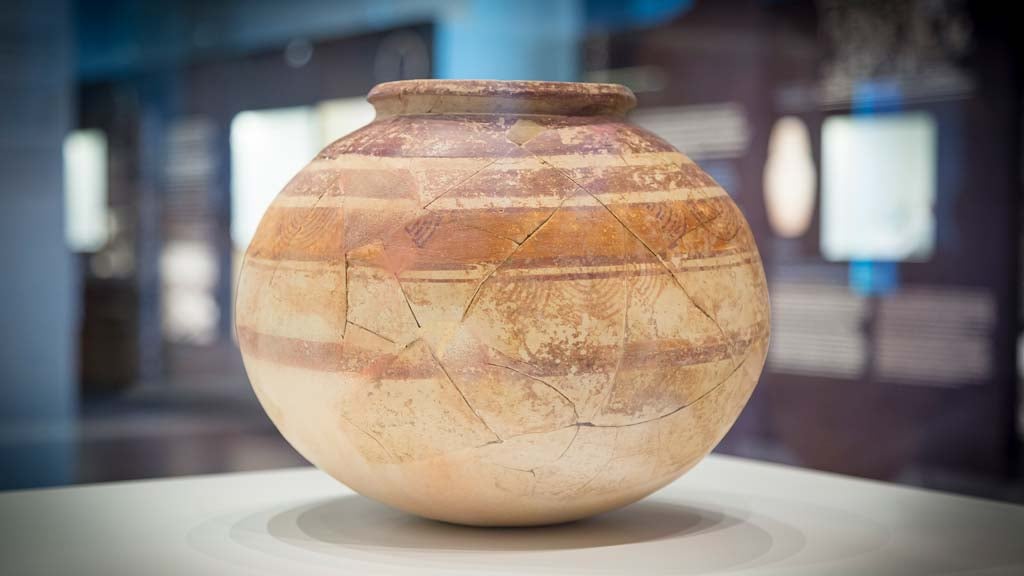
Spherical receptacle with the classic Iberian semicircles in the Museum of Malaga.
PHENICIANS
The Phoenicians were the founders of the city of Málaga, but also of many other cities and small settlements along the Andalusian coast. It was the German Archaeological Institute in Madrid in 1964 who made and dated the first Phoenician colony in Malaga. This was followed by important finds of walls and sanctuaries in the city of Malaga.
ENTERRUM WITH ALABASTRO URNA AND JEWELLERY
From the Phoenician past, the Museum of Malaga exhibits interesting grave goods, such as the shaft tomb from the necropolis of Chorreras. Here a stone cylinder houses an oriental-style alabaster urn containing the cremated remains of a woman and some jewellery.
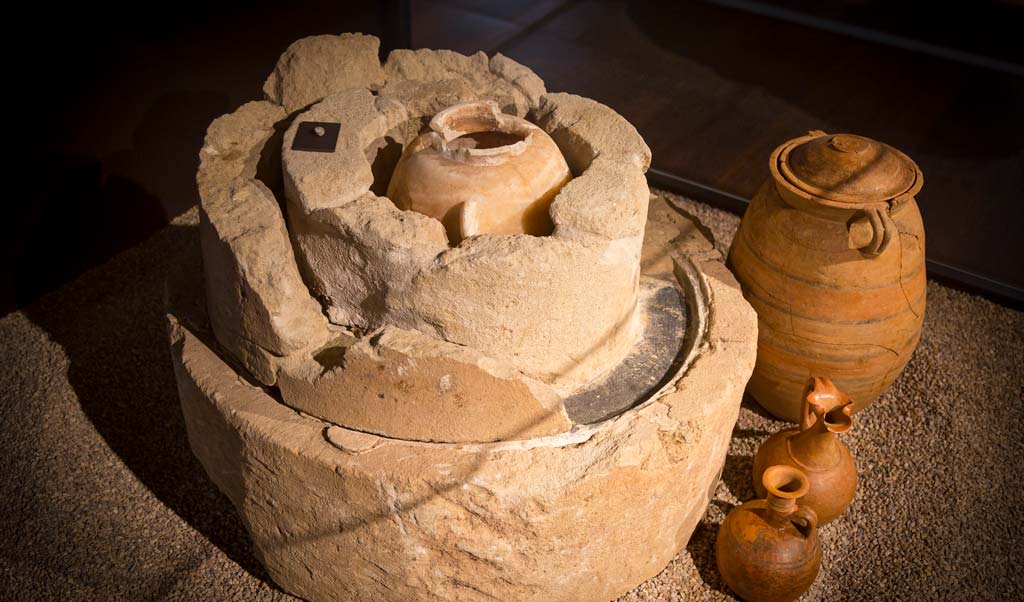
Burial with alabaster urn from the necropolis of Chorreras.
TESORILLO ESCONDIDO
Another curious find we would like to highlight is the treasure of Cerro Colorado (late 3rd century BC). In the nearby town of Benahavís three small ceramic vessels full of coins, ingots and jewels were hidden. The hiding of silver objects used to take place in times of war in order to preserve the fortune in case of siege. 2300 years later you can admire the treasure in the Museum of Malaga.
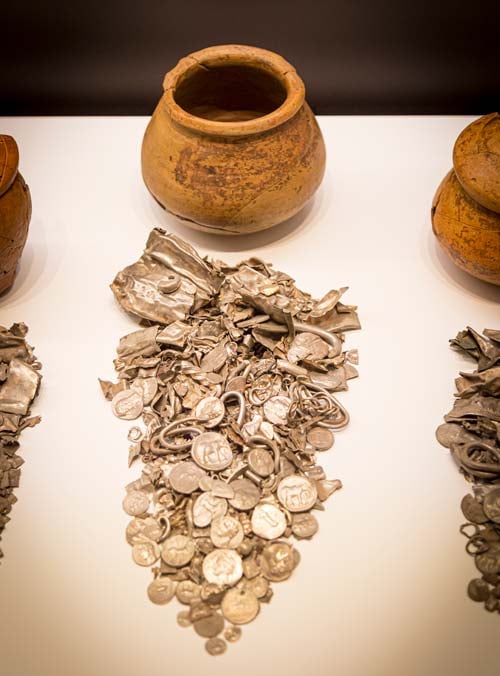
Tesoro de Cerro Colorao in Benahavís (Málaga).
GREEKS
The Greek presence is not as palpable as the Phoenicians, however in Malaga one of the most significant burial sites in Spain was found. It is an intact tomb with Phoenician-style architecture, but which contained the remains and trousseau of a Greek warrior. Of all the pieces found, the Corinthian-style helmet is perhaps the most striking of all.
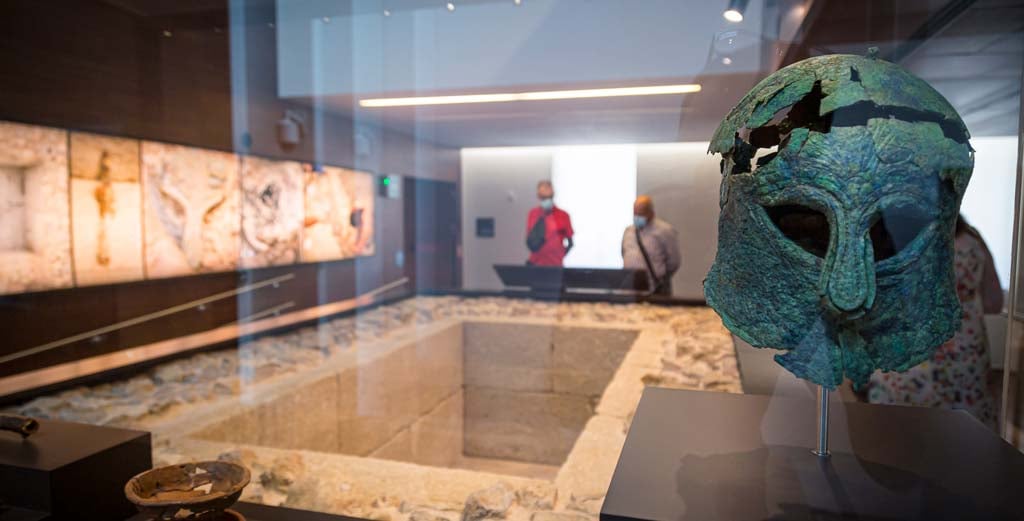
Corinthian helmet from the 6th century BC (Malaga city).
ROMANS
And then it was the turn of the Romans. Malaga grew and was embellished under the Roman world. The Roman Theatre in the capital and the one at Acinipo are two great examples of this, as are the many villas and factories along the coast and inland. The Museum of Malaga exhibits ointments, funerary boxes with bone hinges, architectural pieces, mosaics, etc.
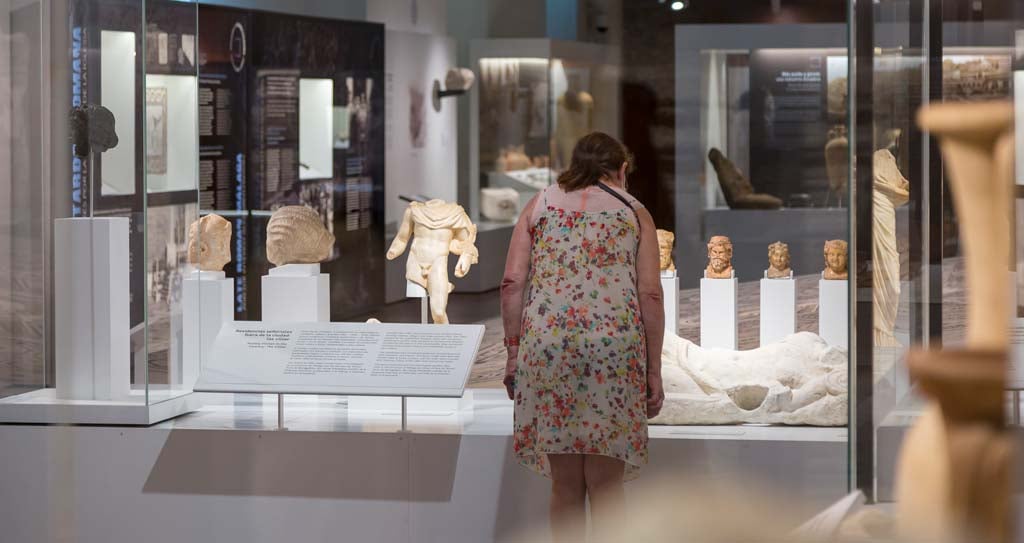
The Roman period of the Museum of Málaga.
CÁRTAMA SCULPTURAL SETTING
We had a hard time deciding, as we have to be selective in order to keep the article short. Finally we have decided to show you the “seated matrons” from Cártama. They are a large sculptural group carved in marble. These marble pieces were found in the 18th century and were part of the collection of the Marquises of Loring. One of them represents Ceres, goddess of agriculture, another represents Juno, goddess of marriage representing motherhood.
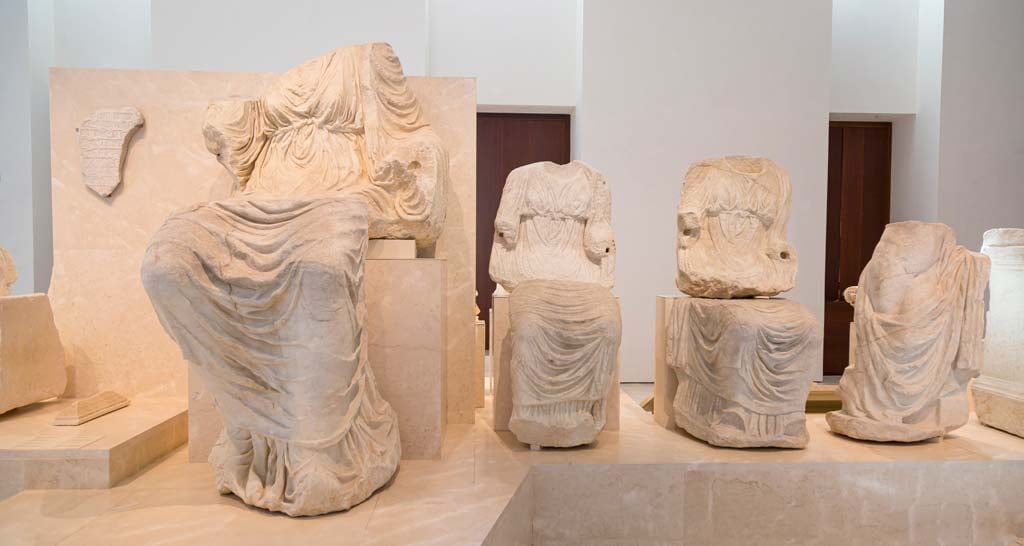
Roman sculptures from Cártama, “seated matrons” from the 2nd century.
AL-ANDALUS
Malaga was Andalusian almost from the beginning of the Middle Ages. It is not surprising that its medieval collections are basically ascribed to this cultural context. The Andalusians worked exceptionally well with materials such as ceramics, plaster and wood. Over time they forged their own style, which is evident in decorative elements such as atauriques and calligraphy. A large part of the materials in the Museum of Malaga come from the Alcazaba, to which we dedicate an extensive article.
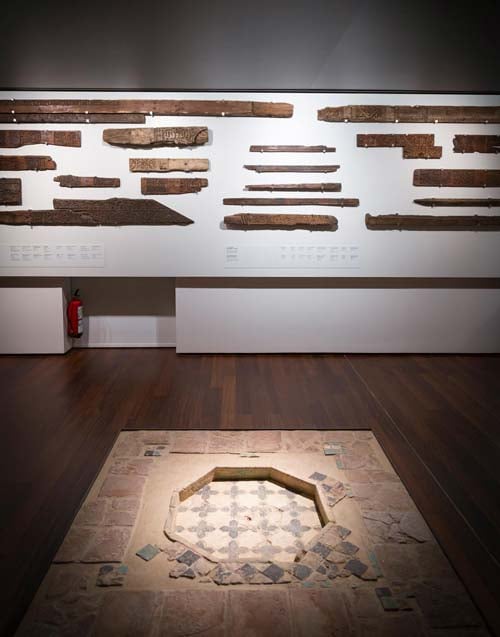
Flat fountain decorated with pieces of tiling from the Nasrid period and collection of Andalusian wood from the Museum of Málaga.
LIONS’ RACE
One of the best-known pieces is a daggerboard decorated with figurative elements such as lions and birds. Although this piece is quite rare, the depiction of animals is common in Islamic culture. The technique used is called cuerda seca (dry rope) and consisted of making drawings with manganese and then filling each space with glazes of different colours. The manganese prevents the colours from mixing before and during the firing of the piece in the kiln. The result is a storage piece with an important sumptuary value. It is considered to date from the transition between the Taifa and Almoravid periods (11th to 12th centuries).
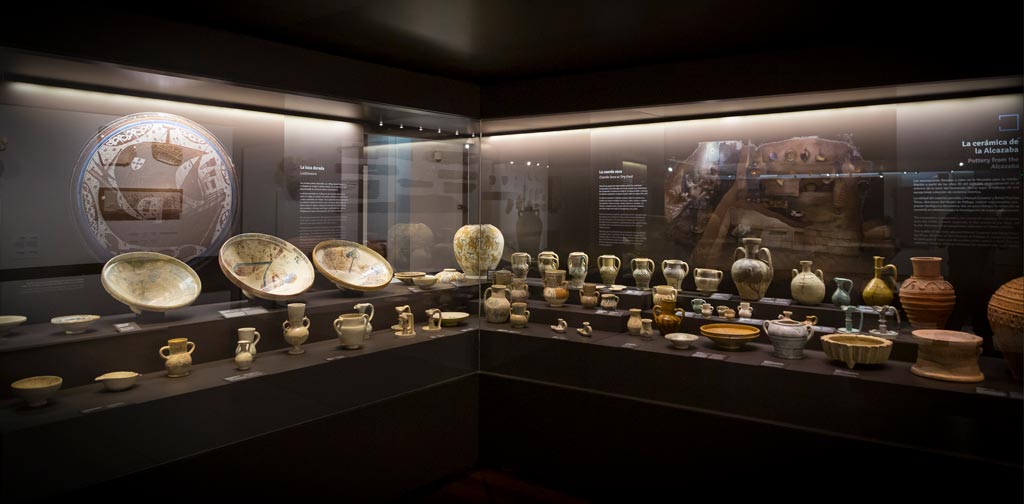
Vitrine with Andalusian ceramics including the lions daggerboard in the middle and the ataifor of the boat on the left side.
TAIFOR OF THE SHIP
The ataifor is one of the main pieces of Andalusian tableware. They were large vessels where food was served and consumed. This ataifor is unique for its excellent preservation of both the piece and its decoration. However, the decorative theme of the vessel was mass-produced during the Nasrid period and centuries before in Mallorca and Denia. Another interesting feature of this piece is the metallic lustre decoration. This technique was imported from the East but developed significantly in al-Andalus, especially from the 11th century onwards. Pieces like this one were exported from the Kingdom of Granada to parts of Europe and the Mediterranean. This piece is dated to the 14th century, the Nasrid period.
MODERN AGE
Works prior to the 19th century play a lesser role in the Museum of Malaga due to the history of the institution itself. However, thanks to Ricardo de Orueta it has a “Room of Old Masters” as mentioned at the beginning of the post.
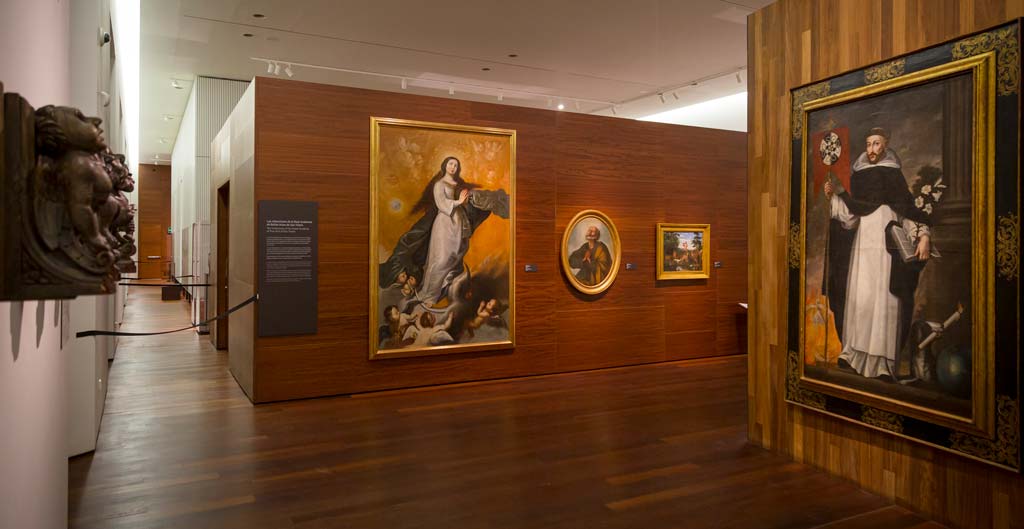
First room with works of the “Old Masters” of the Museum of Málaga.
NINETEENTH CENTURY LANDSCAPE
One of the most developed genres in the 19th century was landscape painting. It was also very important in Malaga due to a special relationship between the Andalusian city and the Belgian school of Namur. Carlos de Haes, the famous Belgian landscape painter, lived in Malaga for many years and encouraged the landscape genre. Some painters from Malaga travelled to the Netherlands to learn about the new genre that was so fashionable. At the same time, the growing bourgeoisie and the incipient tourism demanded decorative paintings with secular themes.
The Museum of Malaga incorporates such curious things as the recreation of pictorial spaces. They are showcases that take us back in time.
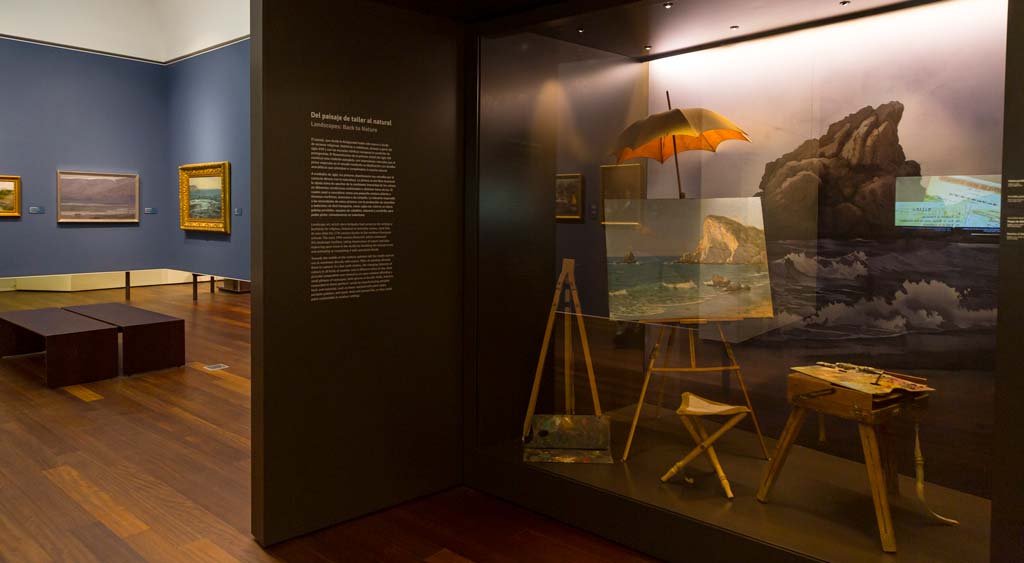
The natural landscape, outdoor painting studio.
MARINES OF THE MUSEUM OF MÁLAGA
The “marinas” or paintings centred on the representation of marine scenes, will be one of the themes with great development in Malaga. It can be considered a sub-genre of landscape painting. The Museum of Malaga has a room with shipwrecks, storms, calm seas, disembarkations, fishermen, etc. It is one of our favourites.
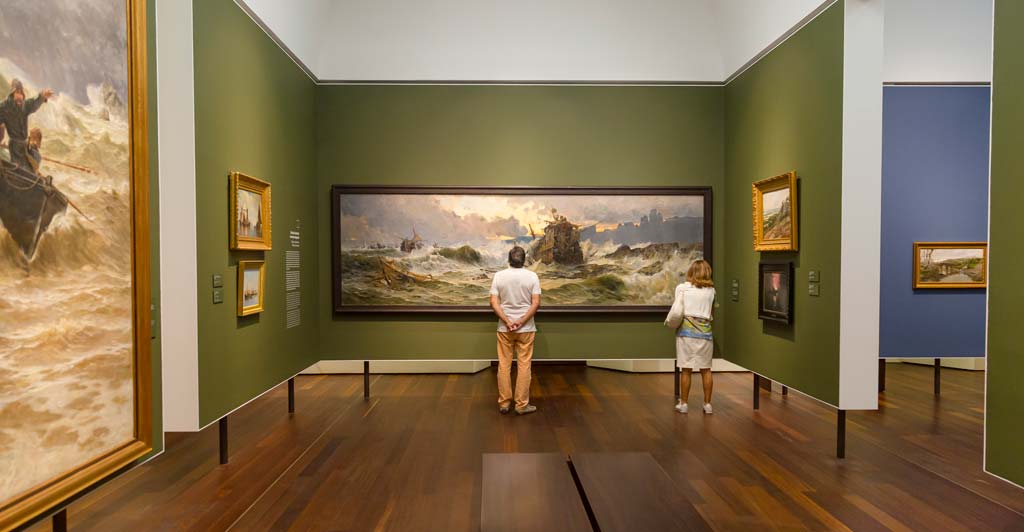
Room with paintings of “marinas” of the Museum of Malaga.
MALAGUEÑA SCHOOL OF PAINTING
Between the end of the 19th century and the beginning of the 20th century, some artists maintained classicist positions, while others opted for the avant-garde. In 1851 the Royal Academy of Fine Arts of San Telmo was established in Malaga. A series of artists in the costumbrista style with close links to the Valencian school were grouped around it. Some art historians have defined their style as “bourgeois realism”. These included Bernardo Ferrándiz y Bádenes, Carlos de Haes, Antonio Muñoz Degrain, Emilio Ocón y Rivas (1845-1904), Enrique Simonet Lombardo, Pedro Sáenz Sáenz and José Moreno Carbonero, among others.
And HE HAD HEART!
Anatomía del corazón or “Y tenía corazón” is a work by Enrique Simonet. The then young artist was enjoying an apprenticeship in Rome, from where he sent this painting to justify his progress. The work was a great success on its arrival in Spain, but it was not without its critics because of the female nude. In our opinion, it is one of the most beautiful paintings in the Malaga Museum.
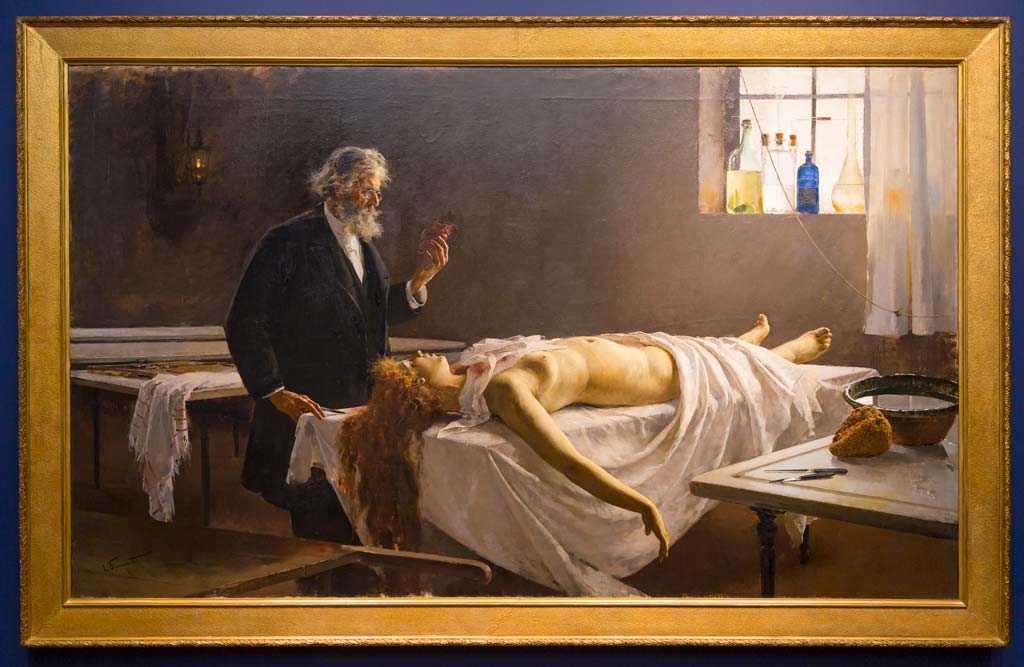
Anatomy of the Heart by Enrique Simonet (1890).
MODERNISM AND SYMBOLISM BY PEDRO SÁENZ
We didn’t know which work by Pedro Sáenz Sáenz Sáenz from Malaga to choose, so we leave you a picture of the wall full of paintings that we liked the most. Modernism is that organic and groundbreaking style that spread rapidly among the bourgeois classes. The Art Nouveau style of Pedro Sáenz represents the concept of sensuality and beauty of the feminine from a man’s point of view.
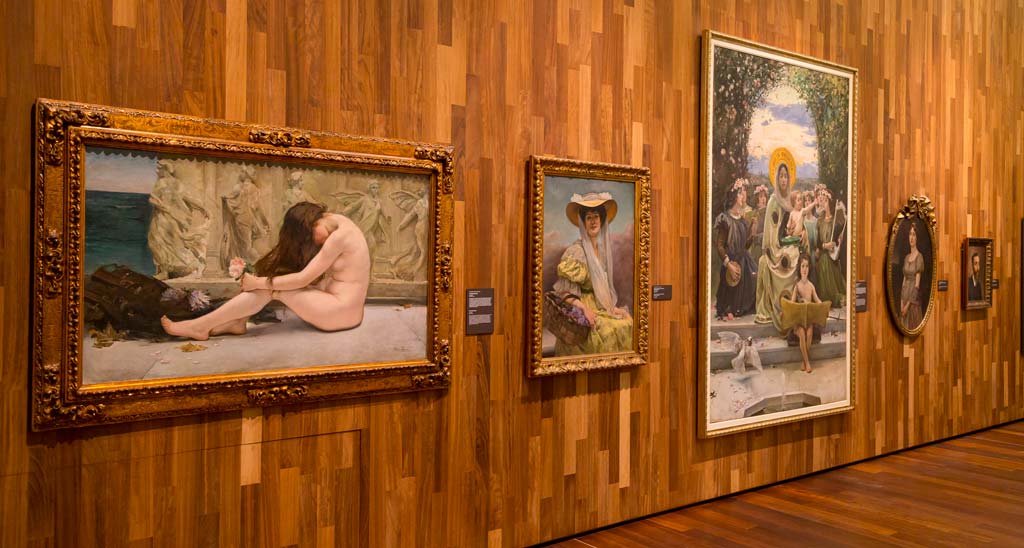
One of the walls dedicated to the work of Pedro Sáenz Sáenz in the Museum of Málaga.
A WOMAN PAINTER IN THE MUSEUM OF MALAGA
IDYLLUM IN THE COVE
We begin with a very special work, the only one painted by a woman on display in the Museum of Málaga. It is called “Idilio en la Caleta” (Idyll in the Cove) and was painted by Flora López Castillo, a member of the symbolist movement. In this seascape she combines landscape and genre painting, depicting the idealised love of two young people on the beach of La Caleta in Malaga.
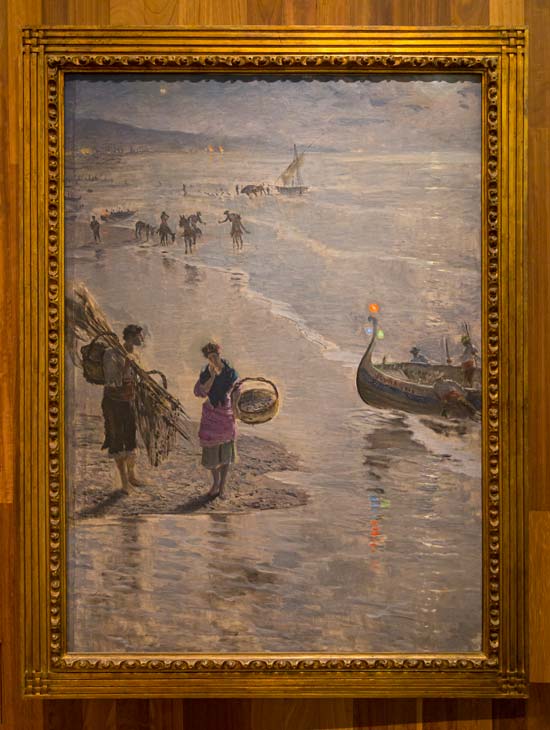
Jábegas, pescadores, copos. Idilio en la Caleta by Flora López Castillo (1914).
VANGUARDS
The Museum of Malaga has several rooms dedicated to the artistic avant-gardes of the 20th century. Compared to the rest of the collection it is not much. As we have mentioned on other occasions, the main volume of works belongs to the 19th century, but visiting these rooms is a nice way to round off an interesting review of the history of Malaga’s art.
PICASSO’S ENGRAVINGS
From the latter rooms we would like to highlight the lithographic folder of “Faunes et Flores d’Antibes” and the burin illustrations of ‘Deux contes’ by Pablo Ruiz Picasso. This is a lesser-known facet of Picasso, that of the engraver. All the works belong to the Jaume Sabartés Legacy. Jaume was a sculptor and writer, a close friend of Picasso, a faithful defender of his work and the artist’s personal secretary.
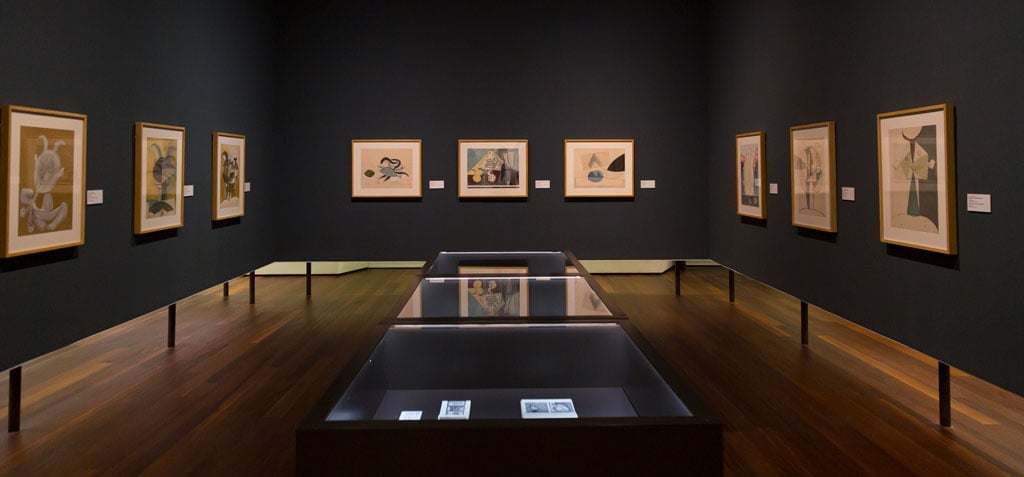
Room dedicated to Picasso’s lithographs.
THE VISITABLE STORE
Yes, it is possible to visit the museum’s reserve area, or at least part of it. This is a trend of the last decade in museums that is gradually gaining ground, and the curiosity of those of us who love history always leads us to want to see more.
The Malaga museum’s visitable storeroom offers a free tour and closer proximity to the collections. It does not have a defined exhibition discourse, but the pieces are grouped according to type, decoration, chronology or size. The objects are displayed on platforms, on shelves or even in drawers, although always without signs.
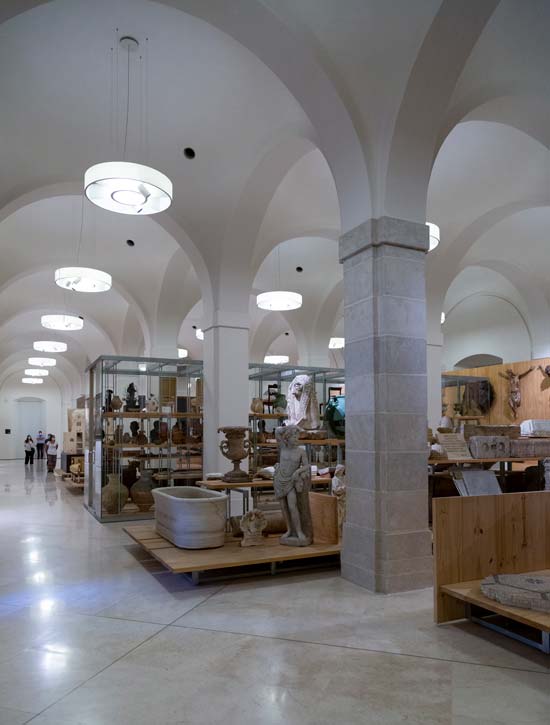
A visitable store without signs where you can play to guess the origin of the pieces.
ACTIVITIES OF THE MUSEUM OF MÁLAGA
The Museum of Málaga is a living institution. The Museum organises concerts, conferences, school visits, temporary exhibitions, gymkhanas and other activities. In addition, its library is open to all those who wish to consult it.
CONCERTS
Music is part of the cultural legacy, so why not include it in the programme of activities of a museum. The Museum of Malaga organises music cycles and occasional concerts. They are almost always of orchestral, classical or popular music.
CONFERENCES
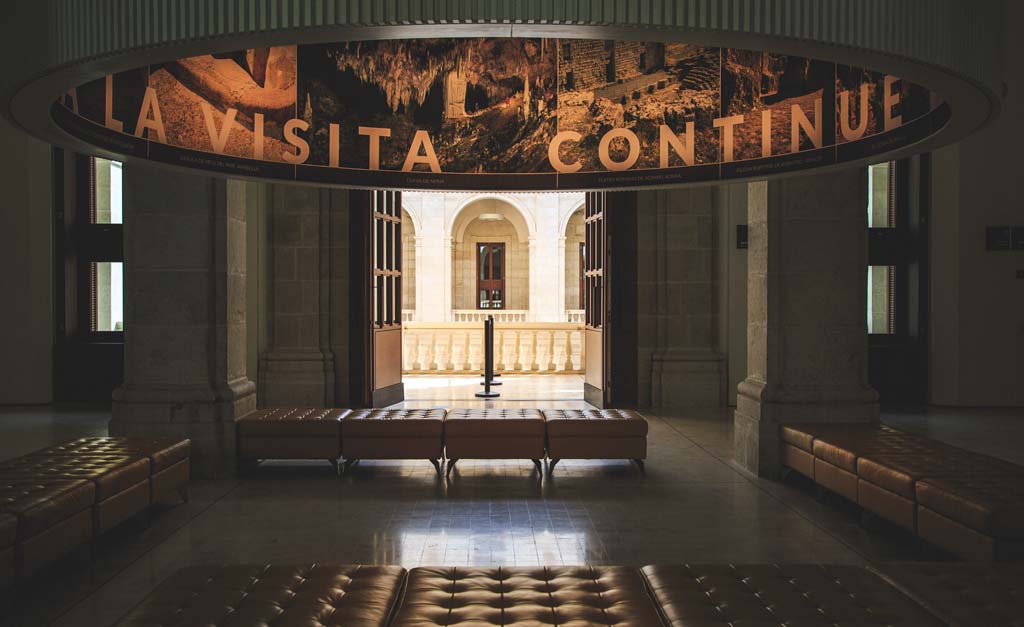
Rest area between floors of the Malaga Museum.
Speeches, talks and conferences are held in the auditorium, or even in the Museum’s own rooms. The Museum participates in cycles such as “Conversations in the Museum” and has the classic “work of the month”. To find out more about the activities, it is best to consult the “News” section of the official website.
CULTURAL GUIDED VISITS
We take a short break in this post to recommend some guided tours of the city that you are going to love. If you’ve come this far, it’s because you’re really interested in culture, so you should definitely get to know “Heart of Malaga” or “Malaga Milenaria“. With a local guide we will put a face to some of the places where a large part of the Museum of Malaga’s collections come from.
VISITING THE MUSEUM OF MÁLAGA
Just entering the museum is impressive. Behind the façade, the hall awaits us, and from there we enter an imposing courtyard where concerts are held. One of the things that impresses us the most when we visit it is climbing the enormous stairs. In this section we tell you all you need to know about how to organise your visit.
HOW TO ORGANISE YOUR VISIT
The Museum of Malaga has four large spaces divided into three floors that must be visited: a visitable warehouse, fine arts, archaeology and temporary exhibition. The visit recommended by the museum itself is from bottom to top, that is, in the order indicated above. However, if you prefer a chronological tour, you should start from top to bottom: archaeology, fine arts, storeroom and temporary exhibition. Here is a brief explanation of each space.
THE VISITABLE WAREHOUSE (GROUND FLOOR) .
Estimated visit time: 30 minutes*.
In museology we no longer speak of a “storage area”, but of a “reserve area”. We have already told you a little about this space above, so we won’t go into it too much. It is located on the ground floor and is the first space to visit.
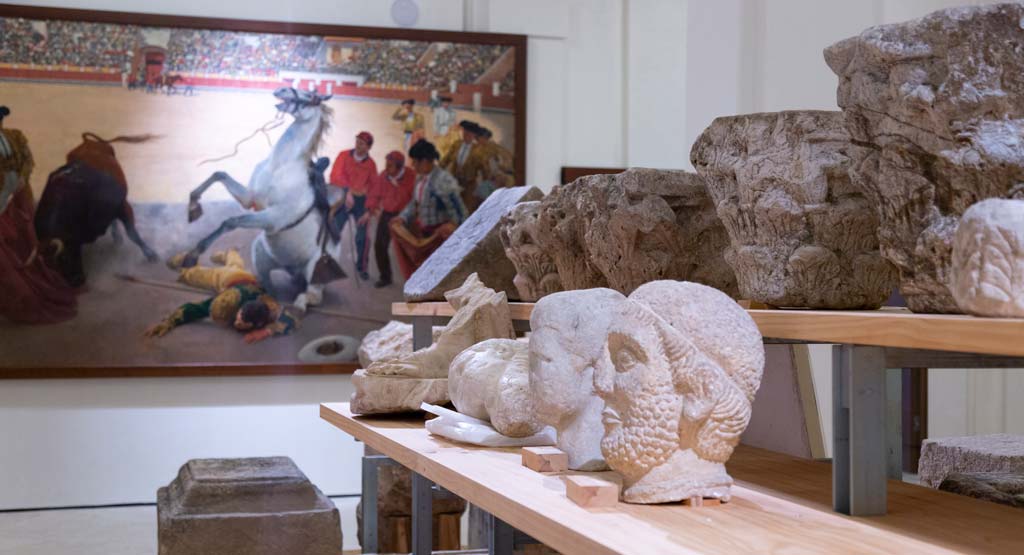
Roman capitals next to great bullfighting paintings from the 19th century, this is the visitable warehouse of the Museum of Malaga.
TEMPORARY EXHIBITION ROOM
Depending on when you visit the museum in Malaga you will find one exhibition or another. In our case we were able to see an exhibition of the Malaga painter Eugenio Chicano. We recommend you leave this room for the end, as the exhibition discourse gets a little lost.
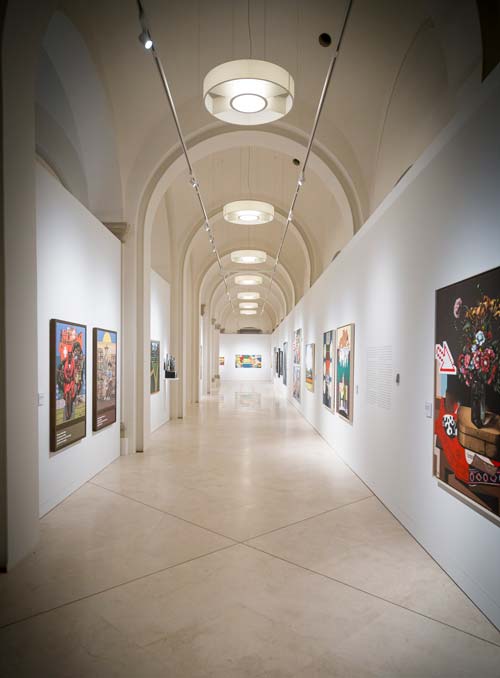
Exhibition of Eugenio Chicano in 2021.
FINE ARTS SECTION (1st FLOOR)
Estimated visit time: 1 hour*
The fine arts rooms of the Museum of Malaga exhibit mainly pictorial and sculptural works from the end of the 15th century to the present day. The discourse is organised chronologically, focusing on themes such as landscape, seascapes or specific painters.
ARCHAEOLOGY SECTION (2nd FLOOR).
Estimated visit time: 1 hour*.
The archaeology collection is our favourite. It presents everyday objects and artistic pieces from prehistory to the Middle Ages. No historical period is overlooked, including such little-studied periods as the Visigothic and Byzantine empires.
HOW LONG DOES IT TAKE TO VISIT THE MALAGA MUSEUM?
The estimated duration of the visit is about 2 hours and a half. The time estimate is based on a relaxed visit, enjoying the works and the information provided by the panels and posters. A more rushed visit would be around 1.5 hours.
VISIT FOR PEOPLE WITH REDUCED MOBILITY
The museum has access for people with reduced mobility. In addition, the museum itself has wheelchairs for loan, adapted lifts and toilets specially designed for their use. During the visit we were able to see that it also has spaces designed for blind people. In these places there are reproductions of the original pieces where you can touch them to recognise their shape and texture.
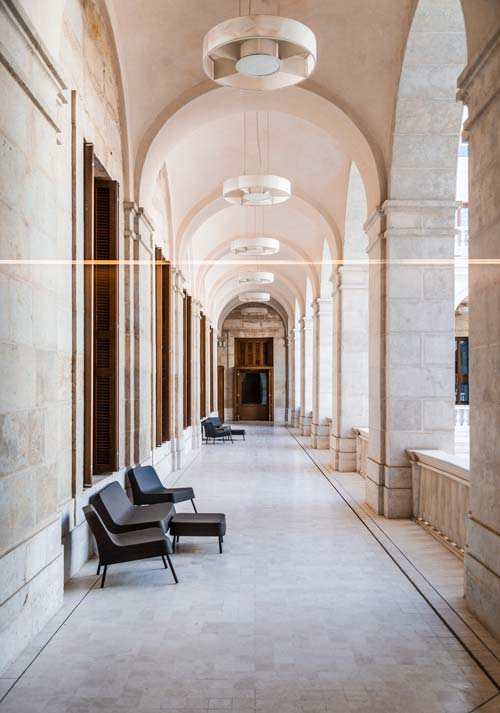
Gallery on the first floor open to the patio of the Palacio de la Aduana de Málaga.
MÁLAGA MUSEUM OPENING HOURS AND PRICES
They have two different opening hours depending on the time of the year.
From 23 June to 30 September
Tuesday to Sunday and public holidays: 09:00 to 15:00.
Monday closed.
From 1 October to 31 December
Tuesday to Saturday: 09:00 to 21:00.
Sundays and public holidays: 09:00 to 15:00.
Monday closed Monday closed.
Closed 1 and 6 January, 1 May and 24, 25 and 31 December.
Price of admission
Admission is free for accredited European Union citizens.
For other non-EU nationalities: €1.50.
BEST TIME TO VISIT THE MUSEUM
Any time is a good time to visit the Museum of Málaga. Except for Mondays and certain public holidays, it is open all year round. In winter there are usually more indoor visits, but Malaga has such a pleasant climate that it doesn’t really matter what time of the year it is. If you are thinking of visiting Malaga we leave you a perfect plan to get to know the city in two days, all measured in detail and based on our experience.
SERVICES OF THE MUSEUM OF MÁLAGA
It has a library, assembly hall, didactic classroom, shop, restaurant, cafeteria, lactation room, cloakroom, wheelchair loan and rest areas.
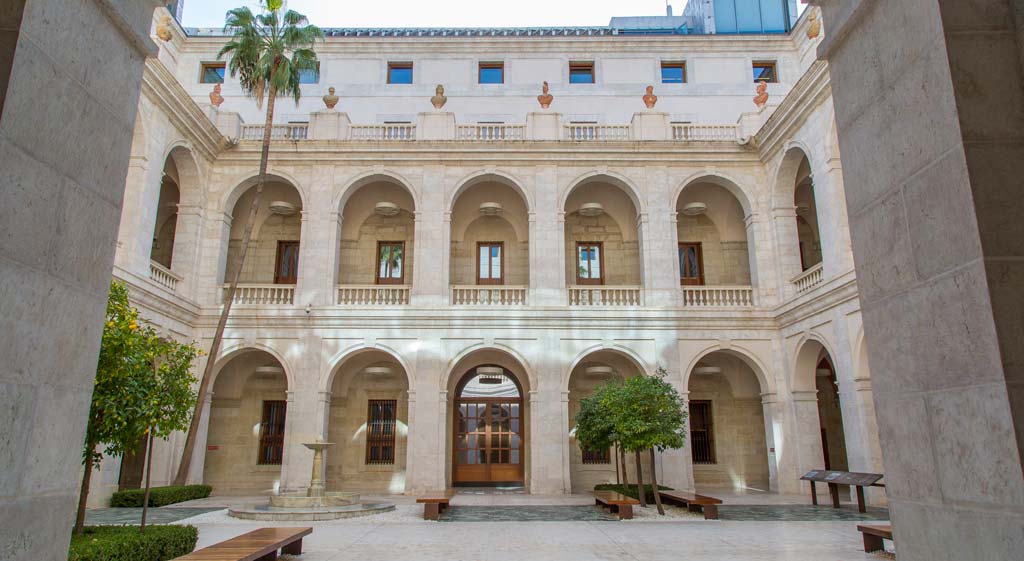
Patio of the Palacio de la Aduana.
ASOCIACIÓN DE AMIGOS DEL MUSEO DE MÁLAGA
This association is, to a large extent, responsible for the current Museum of Málaga. In 1999 they began to fight for the museum to become a reality and for it to have an important venue. They support and promote cultural actions and have more than 1000 members.
We would also like to thank them for their collaboration in creating this article, as they have given us permission to use some of their photographs to illustrate this article.
HOTELS IN MÁLAGA
If you have already decided that you are going to visit Malaga and you still haven’t found your accommodation we recommend that you take a look at the incredible offers on Booking.com.
CONTINUE DISCOVERING MÁLAGA
Guided tours in Málaga / Picasso’s Malaga / The English cemetery
Malaga with charm / Malaga in two days / What to See in Malaga
Viewpoints of Malaga / Alcazaba de Málaga

